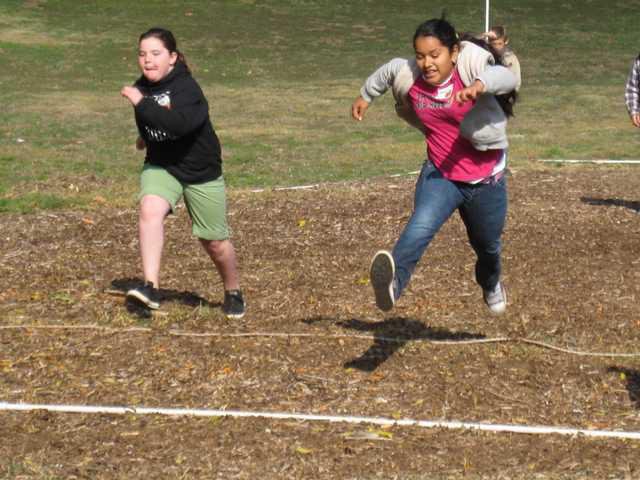Fourth grade students in the Oakdale Joint Unified School District have been learning about the life cycle of Chinook salmon and the lessons recently ramped up with a Salmon Day educational field trip to the Stanislaus River and information center in Knights Ferry.
From the bridge, the students were able to view spawning salmon; they also toured the information center and watched a short movie, learning about the history of the area. The students conducted field experiments such as testing the pH, temperature, and nitrate levels of the river water. They looked through field microscopes and view boxes at various invertebrates that live in the river, and took a nature hike along the river discovering more about its ecology and the habitat of other animals and plants that live near the river. The students also played the salmon game where they pretended to be salmon that had to swim through turbines, avoid predators, and jump waterfalls to survive. The exercise was to show the students how few salmon actually do survive to make it to the spawning ground.
District science teacher Anne Marie Bergen provided a series of classroom lessons at each school for the fourth graders prior to the Salmon Days that included having the students learn about food chains of the salmon at their different life stages. Also covered was what would happen if predation of a particular part of the food chain occurred by a non-native species that was introduced and how that would affect the rest of the animals in the food chain.
Following all the lessons and the Salmon Days, the students will soon have the opportunity to see the beginnings of the life of Chinook salmon up close and personal.
Annually, the fourth grades have received a salmon redd, or nest, with salmon eggs to raise in special tanks in the classroom during the winter. They will track the changes in the eggs and how they develop into tiny fish. The students keep salmon journals where they record information and draw pictures depicting the size and color of the eggs and growing salmon, their behaviors, as well as environmental factors in the tanks such as water temperature.
Due to the small salmon numbers last year, the classrooms received trout eggs instead but the eggs were so small they were difficult to see with the naked eye. Bergen said that as it stands now, she’s been informed that the schools will be getting salmon eggs in January for this school year. From eggs, they will develop into alevin, then into fry where they’ll be about two-inches long around the end of February and will be released into the Stanislaus River near the Knights Ferry bridge in hopes that some will return one day to spawn in the same spot in the Stanislaus River.
Salmon return to their birthplace to spawn the next generation. It is the goal of the Department of Fish and Game as well as the Army Corps of Engineers that care for the river to get more of the salmon to return and help boost the population. The goal is to have 10,000 spawning salmon in the river each year. Over the past couple of years, the number has been less than half that amount.
This district-wide school project meets numerous California life science educational standards for fourth graders including the study of animals, habitat, life chains, as well as investigation and experimentation, and use of equipment such as microscopes. It also covers California history in the study of geography, water systems, the gold rush, American Indians, and the study of human impact over time.
qn Pan appetizer and dessert buffet, $10 worth of raffle tickets, music, and dancing. For tickets or information, contact Jenny Liekhus at (209) 847-4079.





